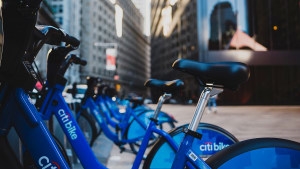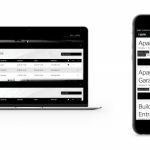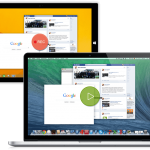Creating A More Equitable Bike Share System Is Possible, But It’ll Take Some Work
Citi Bike, the New York City bike share system, launched in 2013 and by the end of this year will more than double its original size to 12,000 bikes and 700 stations. On peak days, ridership exceeds 60,000 people; annual membership numbers 115,000. But for all it’s done to get more New Yorkers cycling and speed the development of more bike-friendly infrastructure, the benefits of Citi Bike have been slow to reach across demographics. Just 18% of stations are located in zip codes where the median annual income is lower than $50,000, and 83% of trips start and end in Manhattan, where the impression that the majority of blue bikes are piloted by men in suits is due to the fact that men take around 73% of Citi Bike rides.
As bike share programs proliferate across America—there are now around 119, the majority of which have been successful—lack of equity has emerged as an issue. A new study out of the Transportation Research and Education Center (TREC) at Portland State University for the National Institute for Transportation and Communities (NITC) dives into the data showing that white, higher-income populations are overrepresented among bike share users and uses findings from research in three cities—Brooklyn, Chicago, and Philadelphia—to advise on how systems could work to ensure they reach a more diverse user base going forward.
This report is part of a larger effort by TREC to examine equity issues and solutions in bike share programs around the U.S. A previous report, released in May, catalogued specific cities’ efforts to support equity through collaborations with the Better Bike Share Partnership (BBSP), a nonprofit coalition focused on making bike share programs more accessible. BBSP’s effect on the neighborhoods and systems featured in the TREC report include how Philadelphia’s Indego system located a full one-third of its stations in low-income neighborhoods and created a cash-based rental system, and Citi Bike’s recent $5-per-month (as opposed to $15-per-month) membership option for residents of New York City Housing Authority public housing.
But even with these incentives in place, and even as bike share systems like Citi Bike continue to expand into neighborhoods outside the city’s main business hub, membership and usage among lower-income people of color still lag behind more affluent people in those same neighborhoods, Nathan McNeil, lead researcher on the report, tells Fast Company. So the newest report from TREC looks at why: What are the specific barriers that low-income residents and people of color cite as to why they’re not using these systems? And how might bike share programs improve their outreach to address those specific concerns?
In compiling the report, McNeil noted that it was important to keep in mind the difference between barriers to bicycling on the whole, and barriers to bike share use. Solving one common barrier to bike-share use in low-income neighborhoods by adding more docking stations, for instance, does little to assuage the more pervasive concern 48% of residents had about road safety conditions. When Citi Bike was facing pressure in 2016 to expand to more diverse neighborhoods, like Bedford-Stuyvesant in Brooklyn, the New York Times pointed out that the Citi Bike zones in Manhattan were well-served by protected bike lanes, which were much harder to come by in Brooklyn. McNeil cited research that sheds light on the concern lower-income people of color feel about welcoming bike shares to their neighborhoods: Another study found that around 54% of residents in that demographic did not trust that their government would step in to build bike lanes if the community requested them. In order for bike shares to expand successfully in all neighborhoods, cities must be willing to support and follow through on more equitable bike infrastructure developments.
But the TREC report also highlighted two bike share specific concerns that current and future programs could work harder to address. The first is payment method. The TREC study found that only 43% of low-income residents of color in the groups surveyed had a credit card, as opposed to more affluent white residents (98%); just 56% reported having consistent access to the internet. Both circumstances would make managing a bike share account difficult and create a barrier to using the system on a one-off basis.
Philadelphia’s Indego system’s cash payment method allows users to register online to receive a barcode, which they can then bring to a local convenience store to make a payment (similar formats are also available on a more limited basis in D.C.’s and Boston’s systems), but it’s still been tough to attract a more diverse ridership. “We heard over and over again that not knowing this was an option and not knowing how to use the system was a barrier,” McNeil says. Indego’s community ambassador program, which hires locals with roots in the communities that the system is trying to reach, is attempting to bridge that knowledge gap.
Apart from the payment barrier, though, around 52% of lower-income people of color had concerns about liability should a bike share get damaged while in their possession, as opposed to just around 10% of higher-income white users. “These figures reveal that concerns about price and being overcharged for a problem with the bike are related to both income and race,” McNeil wrote in the study. The solution: Follow the model of Chicago’s Divvy system, which set up a loss liability fund through its Divvy for Everyone program, which with a grant from BBSP offers discount memberships and cash-payment options for lower-income residents. While the fund hasn’t yet been needed, taking steps to ensure there’s a safety net, McNeil says, will help to encourage more people to use bike share systems.
While the TREC research project focuses on Brooklyn, Chicago, and Philadelphia, McNeil says that “there were more similarities than differences” in residents’ responses across all three cities, and as such, the information contained in the report can be more broadly interpreted and applied. “One of the great things about this research process was seeing how both community organizations and bike share systems are open to change and interested in better serving all communities,” McNeil says. He and the TREC team will be sharing the findings with bike share operators across the country, as well as at the North American Bike Share Association conference this November. “We know we have a lot of information here about potential barriers and things that will motivate people to overcome them, but it’ll be a process to take this and figure out how to make the right investments to address them,” McNeil says.
The first step is understanding the barriers low-income people of color–who have been long underserved by these systems–face in participating now.
Citi Bike, the New York City bike share system, launched in 2013 and by the end of this year will more than double its original size to 12,000 bikes and 700 stations. On peak days, ridership exceeds 60,000 people; annual membership numbers 115,000. But for all it’s done to get more New Yorkers cycling and speed the development of more bike-friendly infrastructure, the benefits of Citi Bike have been slow to reach across demographics. Just 18% of stations are located in zip codes where the median annual income is lower than $ 50,000, and 83% of trips start and end in Manhattan, where the impression that the majority of blue bikes are piloted by men in suits is due to the fact that men take around 73% of Citi Bike rides.
Fast Company , Read Full Story
(31)













